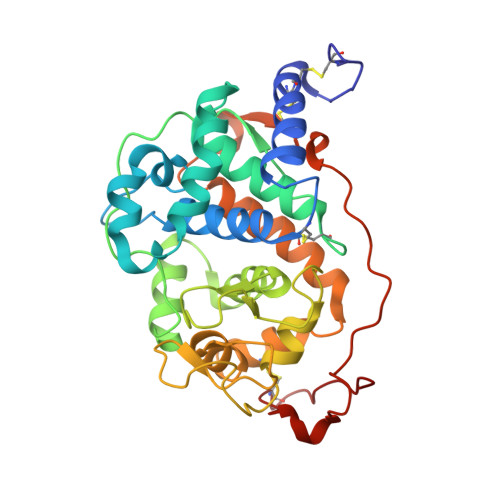Two Oxidation Sites for Low Redox Potential Substrates: A DIRECTED MUTAGENESIS, KINETIC, AND CRYSTALLOGRAPHIC STUDY ON PLEUROTUS ERYNGII VERSATILE PEROXIDASE.
Morales, M., Mate, M.J., Romero, A., Martinez, M.J., Martinez, A.T., Ruiz-Duenas, F.J.(2012) J Biol Chem 287: 41053-41067
- PubMed: 23071108
- DOI: https://doi.org/10.1074/jbc.M112.405548
- Primary Citation of Related Structures:
4FCN, 4FCS, 4FDQ, 4FEF, 4G05 - PubMed Abstract:
Versatile peroxidase shares with manganese peroxidase and lignin peroxidase the ability to oxidize Mn(2+) and high redox potential aromatic compounds, respectively. Moreover, it is also able to oxidize phenols (and low redox potential dyes) at two catalytic sites, as shown by biphasic kinetics. A high efficiency site (with 2,6-dimethoxyphenol and p-hydroquinone catalytic efficiencies of ∼70 and ∼700 s(-1) mM(-1), respectively) was localized at the same exposed Trp-164 responsible for high redox potential substrate oxidation (as shown by activity loss in the W164S variant). The second site, characterized by low catalytic efficiency (∼3 and ∼50 s(-1) mM(-1) for 2,6-dimethoxyphenol and p-hydroquinone, respectively) was localized at the main heme access channel. Steady-state and transient-state kinetics for oxidation of phenols and dyes at the latter site were improved when side chains of residues forming the heme channel edge were removed in single and multiple variants. Among them, the E140G/K176G, E140G/P141G/K176G, and E140G/W164S/K176G variants attained catalytic efficiencies for oxidation of 2,2'-azino-bis(3-ethylbenzothiazoline-6-sulfonate) at the heme channel similar to those of the exposed tryptophan site. The heme channel enlargement shown by x-ray diffraction of the E140G, P141G, K176G, and E140G/K176G variants would allow a better substrate accommodation near the heme, as revealed by the up to 26-fold lower K(m) values (compared with native VP). The resulting interactions were shown by the x-ray structure of the E140G-guaiacol complex, which includes two H-bonds of the substrate with Arg-43 and Pro-139 in the distal heme pocket (at the end of the heme channel) and several hydrophobic interactions with other residues and the heme cofactor.
Organizational Affiliation:
Centro de Investigaciones Biológicas (CIB), CSIC, Ramiro de Maeztu 9, E-28040 Madrid, Spain.


















